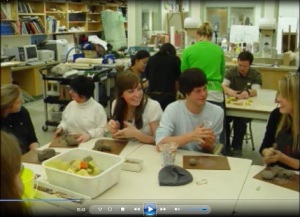Over the past 100 years, society’s support of people with developmental disabilities reads like a hike up Maslow’s Hierarchy of Needs. From institutions that were thought at the time to meet the basic physiological needs of food and shelter, to the reputed consistency and predictability of sheltered workshops, to focusing on developing healthy relationships through Circle of Friends and other programs, to personal achievement found in employment in the community, support has become more enlightened as society’s beliefs about people who have developmental disabilities have become more realistic. It is not surprising that people working to promote inclusion have started to focus on Self-Actualization, the peak of Maslow’s hierarchy of needs. Self-actualization, in the form of creativity, spontaneity, and problem solving, is a concept that should be woven into all the work we do in supporting people to live full and valued lives of their own choosing; it can also be addressed head on in projects that involve the creative arts.
Think about ways you feel self-actualized. It might be going to the opera; it might be meditating; it might be mountain-climbing. These are all activities that make people feel alive, feel human. They are activities where mundane worries go away and we focus on being in the moment, our senses and emotions intertwined. All people deserve to experience moments in their lives like these and we have a responsibility to make this so.
For many people, creativity in the arts is a way of finding value and meaning for themselves. Semiahmoo House’s annual Extravaganza demonstrates how the arts can have a deep impact on personal development and on the community at large. Having once had the responsibility of co-directing a high school drama production of The Breakfast Club, I can speak from experience when I say that the Extravaganza is an immense undertaking that requires collaboration between people with a diverse set of abilities. One of the things that makes a drama production so meaningful is this very teamwork: members of a cast must be open-minded and creative together for the project to succeed. Every Extravaganza I have attended (and I have attended every Extravaganza) has been wildly embraced by members of the community who make up the audience and has demonstrated achievement and self-actualization for the performers and production crew.
The fine arts make space for successful inclusion. Southridge School and Semiahmoo House have a long-standing relationship that involves the fine arts. Inclusionary after school classes that involve drama, sculpture, painting, and media arts have participants of diverse abilities creating together. In the classes, perceived differences disappear and labels become irrelevant. The only label that applies is “artist” and that is what you would see if you were part of the class: a group of like-minded artists creating together.

Click to HERE to play
The fine arts classes echo one of the best things The Council on Accreditation witnessed at Semiahmoo House the last time they visited to gather evidence for their accreditation report: in many of our programs, they could not see who was the worker and who was the person being supported. They saw people working together with purpose but without hierarchy. Creativity allows for this type of relationship.
Being mindful of self-actualization and making space for artistic creativity supports inclusion and enhances the quality and richness of the lives of all people.

